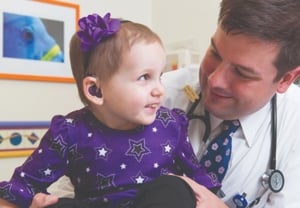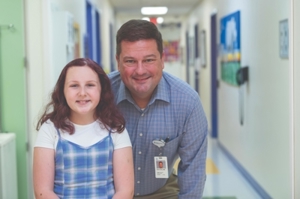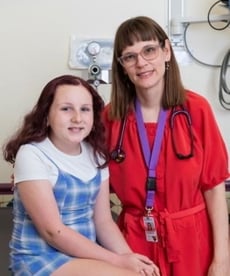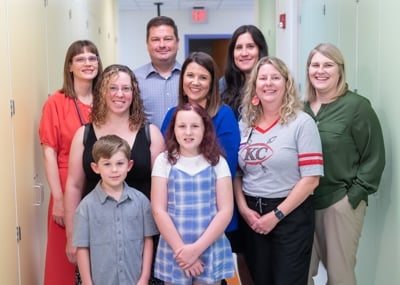Surviving Medulloblastoma, A Decade On
Meet Hailey

Ten years ago, our annual report featured the story of Hailey, a 17-month-old who overcame medulloblastoma, one of the most common pediatric malignant brain tumors. Today, Hailey is an active seventh grader who loves dancing and animals. She’s known for her big heart and sassy personality, not her former diagnosis.
“It was a huge event in our lives, and she went through so much,” said Tricia, Hailey’s mom. “Because she was little, she knows she experienced it, but she doesn’t remember it. Unless I tell people, nobody knows that she had cancer. She’s a ‘normal’ kid now.”
Kevin Ginn, MD, neuro-oncologist and Director of the Pediatric Brain Tumor Program, treated Hailey as a toddler and explained that the highest chance of medulloblastoma relapse is within the first two years.

“We still do MRIs yearly up to at least 10 years out for medulloblastoma,” said Dr. Ginn. "She just had her last imaging and was clean.”
Balancing effective treatment with long-term impacts is a very real part of pediatric oncology. A decade ago, Hailey’s care team opted for three courses of chemotherapy, a stem cell harvest and three courses of high-dose chemotherapy followed by a stem cell rescue. This allowed them to avoid radiation treatment, which can be especially damaging to young children’s developing brain tissue. But high-dose chemotherapy comes with its own short-term and late-effect risks.
“We knew early on that she had an injury to her hearing, a chemo side effect that is extremely common for medulloblastoma treatment,” said Dr. Ginn
Dr. Ginn said they test hearing after every cycle of chemotherapy and make adjustments to the dosage or kind of chemo. Hailey’s high-frequency hearing loss has remained stable since the original chemo-induced injury.
Currently, Hailey visits two Children’s Mercy clinics for annual check-ups: Survive & Thrive and Hearing and Speech.

“In our clinic, we balance making sure families know about late effects and what to watch for...but not be so hypervigilant that they can’t relax and enjoy life,” said Joy Fulbright, MD, director of the Survive & Thrive Clinic, which provides care for around 500 pediatric cancer survivors.
Each patient receives a “passport for care,” which details the cancer care they received, potential effects, and what types of monitoring are necessary. The patient can take this passport with them when they transition to adult care. In Hailey’s case, the drugs that destroyed her brain tumor also put her at high risk for hormonal imbalances and fertility issues as she gets older and at a small risk for secondary leukemia.
“As she becomes a teenager, there are things we have to look out for, so there are still unknowns ahead,” said Tricia. “The clinic is a huge benefit to families. They help you understand the after-effects of cancer and keep you informed.”
Cancer survivors, in general, also have an increased risk of anxiety and depression. The clinic provides psychosocial resources to support families and patients as they transition to life as survivors.
“I think the first five years were probably the hardest,” said Tricia, “because anytime anything happened, you have that word in the back of your head: Okay, does this mean the cancer came back?”
In the beginning, Hailey needed more frequent screenings and was receiving occupational, physical and speech therapy. The appointment calendar was intense, and the family needed to be extra cautious as Hailey’s immune system regained its strength.

Sometimes it was difficult explaining to people why they needed to be vigilant about things like masking and only eating freshly made food. “They’re like, what the heck is neutropenic,” remembered Tricia. “It brings a whole new level of consciousness to germs.”
Once Hailey hit the five-year mark with no relapse, her appointments tapered off to a more manageable level, and her family felt like they could take a breath.
“She was fighting for her life, and now she's a survivor," said Tricia. "You see her personality, how much she’s grown and changed and how strong she is. It’s nice to be on this side of things.”
Learn more about the state-of-the-art clinical care and translational research being done at Children’s Mercy for pediatric central nervous system tumor patients in our 2022-23 Cancer Care Annual Report.